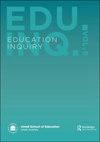编舞复杂性:小学职前教师在大群体中数量操纵的调查
IF 1.6
Q2 EDUCATION & EDUCATIONAL RESEARCH
引用次数: 0
摘要
本研究积累了有关职前教师(n = 62)在编排嵌入代数任务的小组形成时的推理过程的经验证据。这些活动旨在促进对编排形式和数学之间潜在的教学联系的检查,特别强调创建伴随相应代数方程的几何形式设计。本研究采用反思性主题分析,探讨参与者在编舞活动中的体验、意义建构及相关反思。对结果的分析表明,参与者认识到并利用了与方程式中的结构和数学因素的复杂性有关的多种联系。这项研究证实,参与者能够运用越来越复杂的数学模式,在完成嵌入式代数任务的同时,为群体形成生成原创和创造性的舞蹈设计。参与者所采用的发展舞蹈姿势的策略表明,数学模型,特别是那些使用代数和几何结合的模型,对于设计具有灵活性和变化能力的结构安排非常有用。本文章由计算机程序翻译,如有差异,请以英文原文为准。
Choreographing complexity: investigation of elementary preservice teachers’ quantitative manipulation in large group formations
This study accumulated empirical evidence pertaining to preservice teachers’ (n = 62) reasoning processes while choreographing group formations with embedded algebra tasks. The activities were designed to facilitate examination of the potential pedagogical connections between choreographing formation and mathematics, with particular emphasis on creating geometrical formation designs accompanied by corresponding algebraic equations. This study used a reflective thematic analysis to investigate the experiences and sense-making of participants during the choreography activity and related reflection. Analysis of the results revealed that the participants recognised and utilised a multiplicity of connections pertaining to the complexity of the formations and mathematical factors within the equations. This study verified that the participants were able to employ mathematical patterns of increasing levels of complexity to generate original and creative choreography designs for group formations, while completing embedded algebraic tasks. The strategies of developing choreographic positions employed by the participants revealed that mathematical models, especially those using a combination of algebra and geometry, can be useful for designing structural arrangements that are capable of flexibility and change.
求助全文
通过发布文献求助,成功后即可免费获取论文全文。
去求助
来源期刊

Education Inquiry
Social Sciences-Sociology and Political Science
CiteScore
5.00
自引率
0.00%
发文量
34
 求助内容:
求助内容: 应助结果提醒方式:
应助结果提醒方式:


